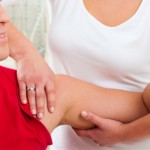
This little Elf recently swam the distance of the English Channel (22 miles or 1416 25m lengths) to raise money for people with spinal injuries. However by the end of the 12 week long challenge I developed a sore shoulder which worsened the more swimming I did. It has got better with rest but it has stimulated an interest in shoulder injuries. First stop the Cochrane database for systematic reviews. Well there just so happens to be a new review on Manual Therapy and Exercise for Adhesive Capsulitis (frozen shoulder).
Frozen shoulder is a common cause of shoulder pain and stiffness. The pain and stiffness can last up to two to three years before going away, and in the early stages it can be very painful. Manual therapy comprises movement of the joints and other structures by a healthcare professional (e.g. physiotherapist). Exercise includes any purposeful movement of a joint, muscle contraction or prescribed activity. The aims of both treatments are to relieve pain, increase joint range and improve function.
Here’s what they did
The authors searched electronic databases up to May 2013 for studies in any language including adults (> 16 years of age) with adhesive capsulitis (as defined by trialists) for any duration. Manual therapy and exercise included; mobilisation, manipulation and supervised or home exercise. Exercises could be land-based or water-based but had to consist of tailored shoulder exercises rather than just general activity (e.g. swimming). They considered over 2000 references and included 32 trials involving 1836 participants.
Here’s what they found
- Among the included participants, 54%were women, average age was 55 years and average duration of the condition was six months.
- The average duration of manual therapy and exercise interventions was four weeks (range one to 18), with a median of three treatment sessions delivered per week (range one to seven) and a median of 12 treatment sessions provided in total across the treatment period (range five to 84).
- Maitland’s mobilisation techniques were the most common type of manual therapy, and Codman’s pendulum exercises, active and passive ROM exercises, pulley exercises and shoulder wheel exercises were themost common types of exercise.
- People who had manual therapy and exercise for six weeks did not improve as much as people who had glucocorticoid injection, improvement in pain was 26 points less (ranging from 15 to 37 points less) at seven weeks (26% absolute less improvement).
- People who had manual therapy and exercise for six weeks did not improve as much as people who had glucocorticoid injection, improvement in function was 25 points less (ranging from 15 to 35 points less) at seven weeks (25% absolute less improvement).
- 31 fewer people out of 100 rated their treatment as successful with manual therapy and exercise for six weeks compared with glucocorticoid injection-31% absolute less improvement (ranging from 13% to 48% less improvement).
- Out of 100 people, three more had minor side effects such as temporary pain after treatment with manual therapy and exercise 56 for six weeks compared with glucocorticoid injection 53.

The authors concluded
The best available data show that a combination of manual therapy and exercise may not be as effective as glucocorticoid injection in the short-term.
It is unclear whether a combination of manual therapy, exercise and electrotherapy is an effective adjunct to glucocorticoid injection or oral NSAID.
Following arthrographic joint distension with glucocorticoid and saline, manual therapy and exercise may confer effects similar to those of sham ultrasound in terms of overall pain, function and quality of life, but may provide greater patient reported treatment success and active range of motion.
The Musculoskeletal Elf’s view

This review has highlighted several key findings. There were slighly more women than men involved in these studies with an average age of 55 years. Does this reflect the characteristis of this population or is this due to greater levels of consent to participate? Interestingly the average duration of symptoms was 6 months at entry to the studies. It is not clear whether participants had recieved treatment in the more acute phase of their shoulder conditions and whether manual tharepy and exercise may have been more effective.
Interestingly no trial compared a combination of manual therapy and exercise versus placebo or no intervention.
- Q. Do you use glucocorticoid injection or manual therapy and exercise as a first line treatment for adhesive capsulitis?
- Q. Does this review make you question your use of manual and exercise therapy?
Send us your views on this blog and become part of the ever expanding Musculoskeletal Elf community.
Links
- Page MJ, Green S, Kramer S, Johnston RV, McBain B, Chau M, Buchbinder R. Manual therapy and exercise for adhesive capsulitis (frozen shoulder). Cochrane Database of Systematic Reviews 2014, Issue 8. Art. No.: CD011275. DOI: 10.1002/14651858.CD011275.
- Aspire Channel Swim

Manual therapy and exercise for adhesive capsulitis http://t.co/ezGhcpZxyq
great article by @MSK_Elf http://t.co/v8H7yfPLqu Would be interested to see a combination of injections and exercise/man ther. to see diff
Good idea. Does anyone know of any trials currently in progress?
Quick review of manual therapy for adhesive capsulitis to get you going today! @UCLanPaST @GregLittler @thebodyrehab http://t.co/CqWZJPuurI
Manual therapy and exercise for adhesive capsulitis http://t.co/IhomuOT4hX @physioMACP @physiowizz
Do you use #Manualtherapy and #exercise for adhesive capsulitis? http://t.co/IhomuOT4hX @csphysio @physioCan @physiotherapyNZ
Is #Manualtherapy and #exercise effective for adhesive capsulitis? http://t.co/IhomuOT4hX @physiotalk @physiopedia @pttalk @PTThinkTank
Should you use #Manualtherapy and #exercise for adhesive capsulitis? http://t.co/IhomuOT4hX @PTHSN @apaphysio @RCGP
#Manualtherapy and #exercise for adhesive capsulitis is it effective? http://t.co/IhomuOT4hX @UKCochraneCentr @CochraneMSK
RT @jpardopardo: RT @MSK_Elf: #Manualtherapy and #exercise for adhesive capsulitis is it effective? http://t.co/OnPNZsDK8d @UKCochraneCentr…
IS #Manualtherapy and #exercise effective forfrozen shoulder? http://t.co/IhomuOT4hX @arthritis_care @ArthritisCareSC
Terapia Manual y Ejercicio en la Capsulitis Adhesiva http://t.co/2urfuCXP1K